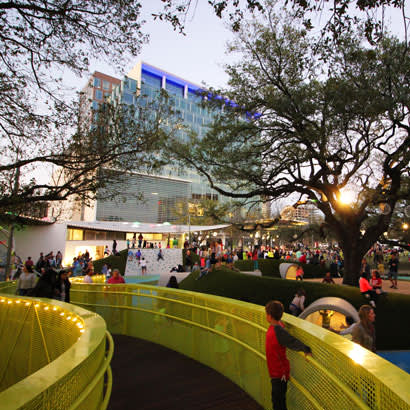
Urban Land Institute calls for more private investment in community-accessible open spaces
The Urban Land Institute (ULI) recently released a report that highlights the business case for real estate professionals to incorporate parks and open spaces into development projects. The Case for Open Space: Why the Real Estate Industry Should Invest in Parks and Open Spaces was created by ULI’s Building Healthy Places Initiative, in collaboration with ULI’s Sustainable Development Product Council members. Members aimed to provide a range of ideas and inspiration for real estate developers as they consider whether to invest in public open spaces.
“The research points to a winning formula,” says Elizabeth Shreeve, the chair of the ULI Sustainable Development Council and principal at SWA Group. “When undertaken thoughtfully, the creation of privately owned or operated, community-accessible open spaces can provide equitable access to resources, strengthen communities, reduce execution risk and contribute to a solid bottom line for real estate investment.”
To build the case, ULI researchers first identified roughly 30 projects across the United States, where private-sector actors contributed to the development, operations, maintenance and/or programming of the park or open space. Stakeholder interviews were then conducted for a subset of projects representing a range of scales and types. These conversations explored how project leaders who pursued various models for partnerships, funding, zoning and local engagement ultimately allowed developers to support project success while delivering significant community benefits.
Through peer-reviewed research and insights from developers, public officials and others working at the intersection of open space and real estate, the report identifies four compelling cases for developers to invest in open space:
Case 1: By investing in equitable access to parks and open space, developers can help improve community health and wellness, boost economic development and enhance a project’s financial success.
Case 2: Developer-supported parks and open spaces can help mitigate the impact of insufficient public resources for parks, thereby providing communities with access to open space while enhancing long-term real estate value.
Case 3: Community-driven programming supported by the private sector can activate open spaces, foster social interaction and strengthen the overall value and marketability of associated projects.
Case 4: Creating or funding parks and open spaces can help developers secure community buy-in, public-sector support and valuable zoning incentives in communities where these incentives are available.
These cases are further illustrated through project examples where private-sector agents supported the integration of open space into their developments and experienced returns on their investments. Projects include:
- Hunter’s Point South: Queens, New York
- Levy Park: Houston, Texas
- Grand Park: Los Angeles, California
- Guthrie Green: Tulsa, Oklahoma
- Solaris Plaza: Vail, Colorado
While the report advocates for more private-sector involvement, industry leaders acknowledge that strong collaboration between public and private sectors are critical to a park’s success.
Levy Park, for instance, a 5.9-acre neighborhood park in Houston, Texas, receives funding for maintenance through a private real estate firm — an agreement that was made with the city of Houston. “The public-private partnership between Midway and the city of Houston’s Upper Kirby District Redevelopment Authority generates ongoing funding for park operations — a great benefit for the people in the surrounding area and an essential investment in the success of Midway’s adjacent projects,” says Ann Taylor, senior vice president of Midway. After its redevelopment, Levy Park became the central component for an 11-acre urban-activity center that now boasts around 10,000 visitors a week, up from only 75 visitors before redevelopment. The park was selected as a 2018 ULI Urban Open Space Award winner.
Rachel MacCleery, senior vice president of content at ULI, emphasized the essential role of public sector and parks departments in this realm when first unveiling the report with ULI members at the 2018 NRPA Annual Conference in Indianapolis. “Parks departments and their government partners — including planning and economic development departments — are critical pieces of the puzzle and play key roles in implementing successful parks projects that involve real estate developers and the private sector,” she explains. “Early conversations about potential opportunities to integrate parks and open space in development projects and win-win approaches are essential.”
As part of the 10-Minute Walk Campaign, the Building Healthy Places Initiative is building on this research by taking a closer look at successful models of cross-sector partnerships, funding mechanisms, zoning strategies and community engagement. Findings from this research will be shared with NRPA and ULI members alike in the hopes of providing public and private land-use professionals with best practices for providing equitable access to high-quality parks around the country.
The ULI Building Healthy Places Initiative:
Around the world, communities face pressing health challenges related to the built environment. For many years, ULI and its members have been active players in discussions and projects that make the link between human health and development; we know that health is a core component of thriving communities. The ULI Building Healthy Places Initiative is building on that work with a multifaceted program — including research and publications, convenings and advisory activities — to leverage the power of the Institute’s global networks to shape projects and places in ways that improve the health of people and communities.
The ULI Sustainable Development Council (SDC):
The Sustainable Development Council aims to accelerate the adoption and implementation of sustainability, resiliency and health across the real estate industry. The council provides a forum for exchange of emerging best practices, including planning, financing, entitlements, design, construction and operational aspects of projects that advance triple bottom-line benefits, while fostering more sustainable built environments.
ULI is grateful to the Robert Wood Johnson Foundation for its support of this research.
Reema Singh is a Manager for The Urban Land Institute.

